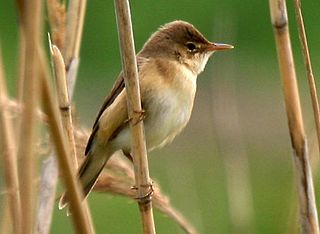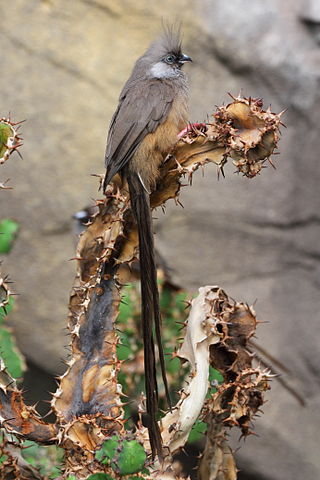
The common reed warbler is an Old World warbler in the genus Acrocephalus. It breeds across Europe into the temperate western Palaearctic where it is migratory, wintering in sub-Saharan Africa. It is also a resident species over large parts of Africa.

The square-tailed drongo, formerly the common square-tailed drongo, is a passerine bird in the family Dicruridae. It is a common resident breeder in parts of southern Africa.

The tawny-flanked prinia is a small passerine bird belonging to the genus Prinia in the family Cisticolidae, a family of Old World warblers. It is widespread and common in most parts of Africa south of the Sahara. The plain prinia of southern Asia was formerly included in this species but is now usually considered to be a separate species.

The grey-backed camaroptera is a small bird in the family Cisticolidae. This bird is a resident breeder in Africa south of the Sahara Desert. Recent studies suggest this species and the green-backed camaroptera may be the same species.

The speckled mousebird is the largest species of mousebird, as well as one of the most common. It is found throughout most of Central, Eastern and Southern Africa.

The cardinal woodpecker is a widespread and common resident breeder in much of sub-Saharan Africa. It occurs in a wide range of habitats, ranging from dense forest to thorn bush. It is fairly vocal and is easily identified by its call notes. The sexes are distinguishable by their head patterns.

The southern boubou is a bushshrike. Though these passerine birds and their relations were once included with true shrikes in the Laniidae, they are not closely related to that family.

The red-faced mousebird is a species of mousebird or coly. It is a common in southern Africa from Zaire, Zambia and Tanzania south to the Cape. Its habitat is savanna with thickets, fynbos scrub, other open woodland, gardens and orchards.

The orange-winged pytilia, also known as the golden-backed pytilia, is a species of estrildid finch found in Africa. It has a wide range and the International Union for Conservation of Nature has assessed it as being of least concern.

The green-winged pytilia is a small colourful seed-eating bird in the family Estrildidae. It is widespread throughout Sub-Saharan Africa, though it is more rarely seen in central, far southern and coastal western parts of the continent.

The cut-throat finch is a common species of estrildid finch found throughout Africa; it is also known as the bearded finch, the ribbon finch, the cut throat, and the weaver finch.

The black-faced waxbill is a common species of estrildid finch found in southern Africa. It is found in Angola, Botswana, Kenya, Namibia, Rwanda, South Africa, Tanzania, Uganda, Zambia and Zimbabwe. The IUCN has classified the species as being of least concern.

The neddicky, or piping cisticola, is a small passerine bird in the family Cisticolidae, which is native to Africa, southwards of the equator. Its strongholds are the light woodlands and shrublands of the subtropics and temperate regions of southern Africa. The common name, neddicky, is the Afrikaans name for the species.

The chestnut-vented warbler, chestnut-vented tit-babbler or rufous-vented warbler is an Old World warbler.

The grey go-away-bird, also known as grey lourie, grey loerie, or kwêvoël, is a bold and common bird of the southern Afrotropics. They are present in arid to moist, open woodlands and thorn savanna, especially near surface water. They regularly form groups and parties that forage in tree tops, or dust bathe on the ground. Especially when disturbed, they make their presence known by their characteristically loud and nasal "kweh" or "go-way" calls, with the last syllable typically a descending drawl. Within their range, their unique combination of colour, appearance and habits precludes confusion with other bird species.

The grey-headed kingfisher is a species of kingfisher that has a wide distribution from the Cape Verde Islands off the north-west coast of Africa to Mauritania, Senegal and Gambia, east to Ethiopia, Somalia and southern Arabia and south to South Africa.

The grey penduline tit, also known as the African penduline-tit, is a species of bird in the family Remizidae. It is found in Angola, Botswana, Burundi, Republic of the Congo, Democratic Republic of the Congo, Eswatini, Kenya, Malawi, Mozambique, Namibia, Rwanda, South Africa, Tanzania, Uganda, Zambia, and Zimbabwe. Its natural habitats are subtropical or tropical dry forests, dry savanna, and moist savanna. At 8 to 9 cm in length and a weight of 6.5 g (0.23 oz), it is one of the smallest species of bird found in Africa, along with its cousin the Cape penduline tit and the perhaps smaller mouse-colored penduline tit and the tit hylia.

The olive-green camaroptera is a bird species in the family Cisticolidae.

Camaroptera is a genus of small passerine birds in the family Cisticolidae that are found in sub-Saharan Africa.

The African pitta is an Afrotropical bird of the family Pittidae. It is a locally common to uncommon species, resident and migratory in the west, and an intra-African migrant between equatorial and southeastern Africa. They are elusive and hard to observe despite their brightly coloured plumage, and their loud, explosive calls are infrequently heard. The plump, somewhat thrush-like birds forage on leaf litter under the canopy of riparian or coastal forest and thickets, or in climax miombo forest. They spend much time during mornings and at dusk scratching in leaf litter or around termitaria, or may stand motionless for long periods. Following rains breeding birds call and display from the mid-canopy.




















